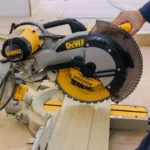Miter saws are one of the most versatile and useful tools for woodworking, carpentry, and DIY projects. They allow you to make precise and accurate cuts at various angles, such as 45 degrees, 90 degrees, or any other angle you need. Miter saws can also cut different types of materials, such as wood, metal, plastic, or composite.
But how do you choose the right size miter saw for your needs? There are many factors to consider, such as the blade size, the cutting capacity, the power, the features, the price, and the portability. In this article, we will explain everything you need to know about miter saw sizes and help you find the best one for your projects.
It Depends on Your Cutting Needs
The size of the miter saw you should buy depends on the size and thickness of the materials you want to cut, and the type and complexity of the cuts you want to make. Generally speaking, the larger the blade size, the larger the cutting capacity, and the more versatile the miter saw. However, larger miter saws are also more expensive, heavier, and harder to transport. Therefore, you need to balance your cutting needs with your budget and space limitations.
Here is a quick overview of the common miter saw sizes and their pros and cons:
7 1/4 inch miter saws: These are the smallest and most compact miter saws available. They are ideal for small projects, such as trimming, molding, or framing. They can cut up to 2×4 inches of wood, and some models can even cut up to 2×6 inches. They are also very affordable, lightweight, and easy to carry around. However, they have limited cutting capacity and power, and they may not be able to handle thicker or harder materials, such as hardwood, metal, or composite.
10 inch miter saws: These are the most popular and widely used miter saws. They are suitable for most medium to large projects, such as furniture, cabinets, or flooring. They can cut up to 2×6 inches of wood, and some models can even cut up to 4×4 inches. They are also relatively affordable, powerful, and easy to find blades for. However, they may not be able to cut very large or thick materials, such as 6×6 inches of wood, or make very complex cuts, such as compound or sliding cuts.
12 inch miter saws: These are the largest and most powerful miter saws. They are designed for professional and heavy-duty projects, such as construction, renovation, or industrial applications. They can cut up to 4×6 inches of wood, and some models can even cut up to 6×6 inches. They can also make any type of cut, such as compound, sliding, or dual-bevel cuts. However, they are also the most expensive, heavy, and bulky miter saws. They also require more maintenance and consume more electricity.
How to Choose the Best Miter Saw Size for Your Projects
Now that you know the basic differences between the miter saw sizes, how do you decide which one is the best for you? Here are some questions to ask yourself before you buy a miter saw:
- What are the typical sizes and thicknesses of the materials you want to cut? This is the most important factor to consider, as it determines the minimum blade size and cutting capacity you need. For example, if you only work with 2×4 inches of wood, a 7 1/4 inch miter saw may be enough for you. But if you work with 4×4 inches of wood, you may need a 10 inch or 12 inch miter saw.
- What are the types and complexity of the cuts you want to make? This is another important factor to consider, as it determines the features and functions you need. For example, if you only make simple crosscuts or miter cuts, a basic miter saw may be enough for you. But if you want to make compound cuts (cuts at both the miter and bevel angles), you may need a compound miter saw. And if you want to make sliding cuts (cuts that extend the cutting capacity by sliding the blade forward and backward), you may need a sliding miter saw. And if you want to make dual-bevel cuts (cuts that can tilt the blade to both the left and right sides), you may need a dual-bevel miter saw.
- What is your budget and space availability? This is the final factor to consider, as it determines the trade-offs you are willing to make. For example, if you have a limited budget and space, you may want to choose a smaller and cheaper miter saw that can still meet your basic cutting needs. But if you have more money and space, you may want to invest in a larger and more expensive miter saw that can offer you more versatility and power.
Conclusion
Choosing the right size miter saw for your needs can be a daunting task, but it doesn’t have to be. By following the guidelines and tips we provided in this article, you can easily find the best miter saw size for your projects. Remember, the size of the miter saw you should buy depends on the size and thickness of the materials you want to cut, the type and complexity of the cuts you want to make, and your budget and space limitations. We hope this article helped you make an informed decision and enjoy your woodworking, carpentry, or DIY projects. Happy cutting!



